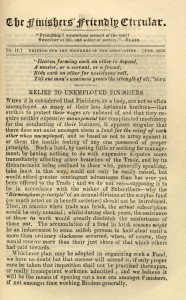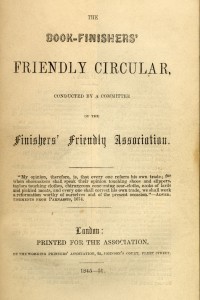This post is the first of a series of features written by our archivist, Jae Mauthe, exploring the development of charitable organizations devoted to social services for bookbinders.
I read a moving post on the British Library’s “Untold Lives” blog a couple years back. It was about an 18th century London bookbinder named Richard Smith. Smith was failing at his trade and a prisoner for debt within liberties to the King’s bench. The Poor Laws had failed him, the Parish workhouses couldn’t help and after paying his landlord what he could, Smith and his wife killed their two year old daughter then hung themselves. This act of total desperation seemed the only way out for the Smith family at the time. I was struck by the level despair and “inveterate hatred for poverty and rags” this man had: he had tried everything and, yet, the series of events that caused this debt convinced him he would forever live a life of ‘numbing poverty’ with no way of seeing his way clear.
Smith’s story of a hopeless tradesman resonated with famous writers of the time. Alexander Pope wrote a small essay, and papers around Europe picked up the story as well. At the British Library Archives a newspaper clipping regarding the murder suicide was also found in a scrapbook of Victorian bookbinder John Jaffray. Jaffray lived a poor man’s life, scraping by as a finishing binder. He had a large family to support and suffered from bouts of bronchitis and gout leaving him underemployed much of his professional life. Living in poverty most of his life and working in various binderies throughout England, Jaffary saw the injustice between the workers and management and wanted to incite change. Jaffary became part of the social reform movement, a member of the London Working Men’s Association, and the Day Workers Society.
Jaffary was alive during a time of much innovation in the bookbinding trade. Industrialization was beginning to change the environment of the workplace from a hand-bound book market to one of machine driven mass-production. The corresponding move away from leather and toward cheaper cloth left many laborers with reduced wages, or out of work. Jaffray began to work towards creating a united front of smaller, often bickering trade groups. He unified finishers, women, day-working forwarders, and piece-workers. These were often the poorest of the bookbinding trade and the workers most often to strike.
The American Bookbinders Museum holds a title in it’s library, The Book-Finishers’ Friendly Circular, Conducted by a Committee of the Finisher’s Friendly Association. London: Working Printers’ Association, 1845-1851. 12mo. This periodical was printed while Jaffray was hard at work making change. It is a record of the development of the bookbinders union and mentions important reforms to the work environment: shortening the work day (reduced from 14 to 12 hours) as well as the development of a pension fund for unemployed workers. Subscriptions were paid into only during the “brisk season” where nominal fees would be collected and during slack times the fee would be waived. Surplus in the pension fund could then be distributed to alleviate the financial difficulties of those out of work. John Jaffray made considerable changes to the plight of his fellow bookbinding craftsmen, ensuring that the lack of support that Smith suffered would not happen again.
-Jae Mauthe
Next in the series: Pension societies and almshouses.



